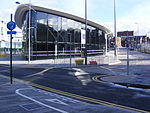Church of St Mary in the Baum, Rochdale

The Church of St Mary in the Baum or Church of St Mary-in-the-Baum is a church in the town of Rochdale, Greater Manchester, England. Commissioned in 1738, and opened in 1742 as a chapel of ease, the chapel was extended in the 19th century. In the very early 20th century the church authorities determined to construct a new building and they commissioned Ninian Comper to undertake the task. Comper designed a completely new church to an unusual plan, due to the constriction of the urban site. He incorporated elements of the original chapel into the new design. St Mary's remains an active parish church in the Anglican Diocese of Manchester. It is a Grade I listed building.
Excerpt from the Wikipedia article Church of St Mary in the Baum, Rochdale (License: CC BY-SA 3.0, Authors, Images).Church of St Mary in the Baum, Rochdale
St. Mary's Gate,
Geographical coordinates (GPS) Address External links Nearby Places Show on map
Geographical coordinates (GPS)
| Latitude | Longitude |
|---|---|
| N 53.6188 ° | E -2.1585 ° |
Address
St Mary in the Baum
St. Mary's Gate
OL16 1DZ , Wardleworth
England, United Kingdom
Open on Google Maps










